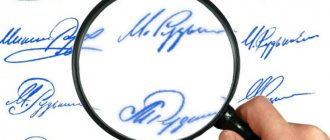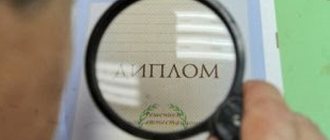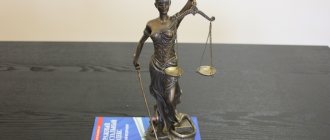Forging a signature is illegal, and therefore may result in administrative or criminal liability. But not in every case, the mere fact of falsifying an autograph will lead to the dock or allow the fraudster to be sent to jail. There must be good reasons for this, about which the journalist FAN the lawyer said Alexey Karabaev.
From the personal archive of Alexey Karabaev /
Article 327 of the Criminal Code of the Russian Federation
Forgery, production or circulation of counterfeit documents, state awards, stamps, seals or forms.
- Part 1. Forgery of an official document granting rights or exempting from obligations for the purpose of its use or sale of such a document, or production for the same purposes or sale of counterfeit state awards of the Russian Federation, RSFSR, USSR, stamps, seals or forms. Punishable by restriction of freedom for a term of up to two years, or forced labor for a term of up to two years, or arrest for a term of up to six months, or imprisonment for a term of up to two years.
- Punishable by restriction of freedom for a term of up to three years, or forced labor for a term of up to three years, or imprisonment for a term of up to three years.
- Punishable by restriction of freedom for a term of up to one year, or forced labor for a term of up to one year, or imprisonment for a term of up to one year.
- Punishable by forced labor for a term of up to four years or imprisonment for the same term.
- Punishable by a fine in the amount of up to eighty thousand rubles, or in the amount of the wages or other income of the convicted person for a period of up to six months, or by compulsory labor for a term of up to four hundred and eighty hours, or by corrective labor for a term of up to two years, or by arrest for a term of up to six months.
general description
Forgery is the illegal alteration of an identity card or other official document. The method of forgery does not affect the qualification of the act and can be anything: erasure, addition, forgery of a signature, certification with a forged seal, re-taping a photograph. The forgery may concern the entire document being counterfeited or part of it, for example, just changing the name on the ID. The complete production of a false document is also considered a forgery.
Sale is the alienation of the subject of a crime, in which its owner changes. As with counterfeiting, the method of sale does not matter for the crime. Sales can be made through sale, exchange, donation, transfer in payment of debt, etc.
Corpus delicti
The main object of the crime is the normal activities of public authorities and management. An additional object is the rights and legitimate interests of citizens and legal entities.
The corpus delicti is formal. The crime is completed from the moment of counterfeiting for the purpose of selling or manufacturing the items specified in the disposition of the article.
The subjective side is characterized by guilt in the form of direct intent and a special purpose - to use or sell a counterfeit or manufactured object of a crime.
The general subject of the crime is a sane person who has reached the age of 16.
Forgery of documents when registering a car
Quite often in investigative practice there are cases of forgery of documents when selling or registering a car. As a rule, this is the forgery of a vehicle passport in order to change the registration data for a car or hide information about previous owners. Often, the perpetrators also falsify the car registration certificate, where they indicate themselves as the owner. Such actions entail criminal liability under Article 327 of the Criminal Code of the Russian Federation. If it is established that the falsification of documents for a car was carried out to obtain property benefits, such actions are subject to qualification under this article in conjunction with Article 159 of the Criminal Code of the Russian Federation.
Forgery of purchase and sale agreement
Forgery of sales and purchase agreements occurs, as a rule, to obtain property benefits. For example, a person makes changes to an existing purchase and sale agreement and changes the amount in it to a greater amount than it was originally. In this case, there is an attempt at fraudulent activity. Since civil contracts are not the subject of this crime, a person is subject to criminal liability only if these actions are necessary for the latter to commit another crime (for example, fraud).
Passport forgery
Passport counterfeiting has become quite widespread in recent years. The forgery of this personal document is essentially no different from the forgery of other documents and is qualified under Article 327 of the Criminal Code of the Russian Federation. And again, if falsifying a passport is necessary to illegally obtain a loan, or to obtain other property benefits, the act should be classified as a set of crimes.
Why do you even need a signature?
A person’s personal signature is an object of his intellectual property . It is confirmation that a specific person, whose surname and initials appear next to the signature, actually signs this or that document.
This is like a guarantee that no one can lay claim to the rights of another person. The signature must be resistant to forgery; it must contain at least one letter from the person’s first or last name.
The person who owns the signature must reproduce it correctly himself, as well as write it quickly. However, today many scammers forge signatures. Why do they need this?
Damage and limitation periods under Art. 324, 327 of the Criminal Code of the Russian Federation
According to the norms of the Criminal Code, in order to bring the guilty person to criminal liability under Art. Art. 324, 325, 327 of the Criminal Code of the Russian Federation, the amount of damage caused does not matter, since these types of crimes have a formal composition. Thus, as soon as the guilty person has committed one of the actions included in the objective side of the crime (produced a fake document, purchased or sold an official document, stole a passport, etc.), the crime is considered completed. At the same time, in practice there are cases when a person steals documents from the victim that contained money (for example, in the cover of a passport or ID). In this case, his actions form a set of crimes - in terms of theft of documents - under Article 325 of the Criminal Code of the Russian Federation, in terms of theft of funds - under Art. 158 of the Criminal Code of the Russian Federation.
The statute of limitations for criminal prosecution under these articles of the Criminal Code of the Russian Federation in all cases is 2 years from the date of commission of the crime, since these offenses relate to crimes of minor gravity (the maximum punishment does not exceed 3 years of imprisonment).
Changing originals
A document is considered false if the following changes are found in it that distort its true meaning:
- correction of all or part of the information;
- erasing part of the information or completely deleting it;
- introducing additional signs;
- replacing a photograph on an identity document;
- falsification of a signature or seal.
There are many technical, laboratory and visual methods for identifying counterfeit documents. Experts can identify and confirm any changes made to the original.
Using a knowingly forged document
General concept
The use of a knowingly forged document (Part 3 of Article 327 of the Criminal Code of the Russian Federation) is an independent crime. Use means that the perpetrator extracts or tries to extract useful properties of the document, for example, applying for a job using a fake higher education diploma, free travel on transport, etc. The use of the document is carried out in the form of its presentation, delivery, transfer, etc. The use of a knowingly forged document is considered a completed crime from the moment it is presented, regardless of the achievement of the purpose for which it was presented.
In Part 3 of Art. 327 of the Criminal Code of the Russian Federation there is no indication of a criminal law ban on the use of an official document. Therefore, a personal document should also be recognized as the subject of this crime.
Qualification Features
The use of a knowingly forged document by the person who committed the forgery is covered by Part 1 of Art. 327 of the Criminal Code of the Russian Federation, and additional qualifications under Part 3 of Art. 327 of the Criminal Code of the Russian Federation is not required.
A deliberately forged document can also be used to commit crimes of various kinds. At the same time, the qualification of acts is carried out depending on the content of the crime.
So, for example, the actions of a conscript or a person performing alternative civil service who forged an official document and used it to evade conscription for military service or dismissal from alternative civil service are subject to qualification under a set of crimes provided for in Part 1 or Part 2, respectively. Art. 328 and part 1 of Art. 327 of the Criminal Code of the Russian Federation. If these persons only used a deliberately forged official document, then the act should be qualified under Part 1 or 2 of Art. 328 and part 3 of Art. 327 of the Criminal Code of the Russian Federation.
A person who, at the request of a conscript or a person performing alternative civil service, has forged an official document in order to evade conscription for military service or dismissal from alternative civil service is subject to liability under Part 5 of Art. 33, part 1 or 2 tbsp. 328 and part 1 of Art. 327 of the Criminal Code of the Russian Federation.
Presentation of someone else's passport
Presentation of someone else's passport as such does not entail criminal liability unless the person's actions contain another crime. For example, if the guilty person has previously committed the theft of someone else’s passport, then his actions contain the elements of a crime provided for in Article 325 of the Criminal Code of the Russian Federation, which provides for liability for theft of a passport.
The theft of someone else's property or the acquisition of the right to it by deception or abuse of trust, committed using an official document forged by this person that grants rights or relieves one from obligations, is qualified as a set of crimes provided for in Part 1 of Art. 327 of the Criminal Code of the Russian Federation and the corresponding part of Art. 159 of the Criminal Code of the Russian Federation.
If a person forged an official document, but due to circumstances beyond his control did not actually use this document, the act should be qualified under Part 1 of Art. 327 of the Criminal Code of the Russian Federation. The act must be qualified in accordance with Part 1 of Art. 30 of the Criminal Code of the Russian Federation as preparation for fraud, if the circumstances of the case indicate that the person’s intent included the use of a forged document to commit crimes under Part 3 or 4 of Art. 159 of the Criminal Code of the Russian Federation.
In the event that a person used a forged document he himself produced for the purpose of stealing someone else’s property by deception or abuse of trust, but due to circumstances beyond his control was unable to seize the victim’s property or acquire the right to someone else’s property, the act should be qualified as a set of crimes provided for in Part 1. 1 tbsp. 327, as well as Part 3 of Art. 30 of the Criminal Code of the Russian Federation and, depending on the circumstances of a particular case - the relevant part of Art. 159 of the Criminal Code of the Russian Federation.
Signature forgery: in what cases does it occur?
Such an offense is resorted to for various reasons, for example:
- the candidate for the post of head of the house (chairman) forges the signatures of people living in a particular house in order to gain the opportunity to become the head of the house;
- the student forges the signature of his teacher in the grade book in order to prove to him that he allegedly already has a grade for the exam, on this basis he must rearrange it in the report;
- the performer of some work forged the signature of his customer, although in fact he did not accept the work;
- the accountant forges the signatures of other employees of the organization for the salary they allegedly received, etc.
Victim's statement about document theft
The basis for initiating a criminal case for the theft of documents is a statement from the victim, in which it is necessary to set out in detail the circumstances of the incident - where, when and under what circumstances the loss was discovered; what document was stolen (series and number); requirement to bring the perpetrator to criminal liability.
Based on the said application, as well as information from the victim obtained during his interview after the application was accepted, the preliminary investigation body makes a decision to initiate a criminal case or to refuse it.
What to do if you are accused of forging a signature?
Is your teacher accusing you of forging his signature on a record book? A co-worker insists that you forged his signature on a payroll slip? How to prove your innocence of forging a signature on a document?
To do this, you need to order a handwriting examination at the Forensic Examination Center. The examination is carried out as follows:
- the specialist compares the signature of the person whose handwriting was falsified with the signature on the document;
- then he asks the person who owns the signature to write a handwritten text on paper, where he will have to indicate the full last name, first name, patronymic, and also sign.
Based on these studies, the specialist gives his written assessment of the results of the examination.
If it was not you who forged the signature, but it was actually put down by the person whose initials were listed next to the signature, then the results will say that the signature on the document is identical to the one on the passport or on the experimental sheet, which means that the document is not fake.
Grounds for exemption from criminal liability
The grounds for exemption from criminal liability in this category of cases are reconciliation with the victim (in the case of theft of documents), as well as active repentance and the insignificance of the crime committed. These grounds are common to most criminal cases. Let's look at them in more detail.
Active repentance is provided for in Article 75 of the Criminal Code of the Russian Federation.
Exemption from criminal liability due to active repentance is possible only if the following conditions are met.
- Firstly, this rule applies only to a person who has committed one or more crimes for the first time, for none of which he has previously been convicted, or when his previously committed acts do not entail legal consequences.
- Secondly, the crimes committed must be classified as minor or moderate in severity.
- Thirdly, after committing a crime, the perpetrator must show active repentance, i.e. take any active positive actions, an approximate list of which is given in Art. 75 of the Criminal Code. These include: surrender; assisting the offender in solving the crime he committed; voluntary compensation for damage caused; otherwise making amends for harm caused as a result of a crime (elimination of physical destruction or damage caused by one’s labor; making amends for moral harm caused: apologizing for the insult caused, refuting false information that discredits the honor and dignity of another person or undermines his reputation, etc.) .
Making amends for the harm caused by a crime in another way is a general formulation that can cover actions of a wide variety of factual content.
Reconciliation with the victim in a criminal case is provided for in Article 76 of the Criminal Code.
Exemption from criminal liability in connection with reconciliation with the victim is possible only if the following conditions are met: the act must be committed for the first time; mild or moderate severity; the accused or suspect is obliged to make amends for the harm caused by the crime and reconcile with the victim.
Depending on what kind of harm is caused (moral, material or physical), making amends for the harm can be expressed in different forms. If harm is caused:
- - moral, then, as a rule, it is enough to make amends for it with sincere repentance for what was done and a request to the victim to forgive the criminal act committed. However, sometimes this is not enough, and the victim is satisfied only with a public apology from the perpetrator, made in a certain form for a wide range of people;
- - material, then it is smoothed out by real compensation in monetary or other form (for example, by repairing a damaged item, providing another item in place of the damaged one, etc.);
- - physical, then the harm can be mitigated by providing various types of medical services to the victim at the expense of the perpetrator, but is often compensated through monetary compensation, the amount of which is determined by agreement between the victim and the person who committed the crime.
Only all four conditions together form the basis for releasing the person who committed the crime from criminal liability due to his reconciliation with the victim. It refers to the inappropriateness of bringing to criminal responsibility the person who committed the crime.
Application Form
The legislator does not force the use of a standard sample application for falsification of evidence, since such a document has not been provided. It is enough to follow the rules for drawing up a statement of claim established by the Code of Civil Procedure of the Russian Federation.
In accordance with the law, the party alleging falsification of evidence and requesting its verification must:
- Correctly indicate the details of the court to which you are applying.
- Describe the physical evidence that is in doubt.
- Substantiate your doubts with facts and specify your request for verification.
- Attach documents confirming or refuting legal facts relevant to the case.
Based on the results of the inspection, the court, based on the results of the research conducted or based on new facts presented by the parties, recognizes the evidence as fraudulent and excludes it from the case or vice versa. Falsification of physical evidence is a criminal offense.
petitions (applications):
Difference from related compositions. Set of crimes
Theft by a person of someone else's property or the acquisition of the right to it by deception or abuse of trust, committed using a forged official document produced by another person, is fully covered by fraud and does not require additional qualifications under Art. 327 of the Criminal Code of the Russian Federation.
In cases where a person, in order to evade paying taxes and (or) fees, falsifies official documents of an organization that grant rights or exempt from obligations, as well as stamps, seals, forms, what he has done, if there are grounds for it, entails criminal liability in the aggregate crimes under Art. Art. 198 or 199 and Art. 327 of the Criminal Code of the Russian Federation.
If the forgery of an official document is preparation for committing theft, for example fraud, the act should be qualified under Part 1 of Art. 30, art. 159 of the Criminal Code of the Russian Federation. Forgery of an official document by an official or civil servant or employee of local self-government bodies who are not officials, if there are appropriate signs, can be qualified under Art. 292 of the Criminal Code of the Russian Federation as official forgery.
In some cases, the presence of a crime under Part 1 of Art. 327 of the Criminal Code of the Russian Federation, is determined in practice based on the intended purpose of using a fake document.
Thus, in the case of B.M. it was established that he had prepared a counterfeit bill of exchange not for its subsequent sale as a security, but for investment in the materials of the criminal case instead of the bill of exchange existing there.
Under such circumstances, the actions of B.M. were reclassified from Part 2 of Art. 186 of the Criminal Code of the Russian Federation on Part 1 of Art. 327 of the Criminal Code of the Russian Federation as a forgery of an official document granting rights for the purpose of using it as such, and not as a means of payment.
Author of the article
Kuznetsov Fedor Nikolaevich
More than 15 years of experience in the legal field; Specialization - resolution of family disputes, inheritance, property transactions, disputes over consumer rights, criminal cases, arbitration processes.
Methods of forgery and what is faked
I think many will be interested in what documents are forged most often. And what’s also interesting is how the attackers make these fakes. Let us consider with you the so-called manual and several technical methods of falsifying important documentation.
"Manual" method
Forging someone’s signature, as they say, “from memory” is the easiest for experts , since a real specialist will be able to distinguish a fake from the original by various strokes and characteristic curls, and without special equipment.
In addition, it happens that the documentation is signed by someone who has never even seen a real signature, that is, he does not know what to forge. In such situations, an examination may not be assigned to determine a forged signature, since everything is already “transparent”.
Read how to write a statement about a false denunciation to the police.
And here is the question of whether it is necessary to change the STS when changing registration.
Useful article “Responsibility under Article 161 of the Criminal Code of the Russian Federation - Robbery.”
Technical methods of counterfeiting
Technical methods are called counterfeiting techniques using additional means, including the most modern computer technology. Forensic scientists distinguish the following methods:
- Using computer technology - a laser printer or scanning machine.
- Copying - through glass, by pressing or using a copy sheet.
- Redrawing from the original.
- Transferring dye from the original itself to a fake sample using egg white or an emulsion layer of photographic paper.
Types of documents
The most popular for forgery are:
- passports;
- birth certificates;
- driver's license;
- military tickets;
- WWII, pension and labor veteran certificates;
- labor and order books;
- sick leave;
- powers of attorney, notarized;
- service certificates;
- diplomas and certificates of education.





